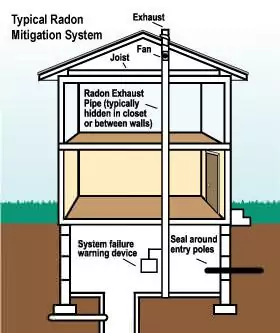Radon Removal and Testing
Because radon is odorless, tasteless and invisible, the only reliable way to detect it in your home is through reliable radon testing. If an unsafe level of radon is detected in your home, our specialists at Specialty Environmental can install a customized radon mitigation system that can reduce your home’s radon levels.
At Specialty Environmental, we provide homeowners in our service area with in-home consultations for radon removal and radon abatement.
We service homes throughout Pasco, Walla Walla, Richland, Liberty Lake, Pullman, Coeur d’Alene, Post Falls, and surrounding areas.

Expert Radon Mitigation Solutions
At Specialty Environmental, our radon exerts are trained in accordance with the highest industry standards in the proper installation of radon mitigation systems. These systems are designed to pull radon from the home, expelling it safely outside.
In addition to their training, each of our contractors is also fully licensed to perform all required radon services—operating within full compliance of the radon gas industry’s best practices. This ensures that the highest quality solutions have been provided, and that the highest standards are implemented.
The way your radon mitigation system is designed will depend on multiple design components present in your home. For example, the existence of a basement or crawl space (instead of a slab foundation) will be a significant determining factor in choosing which mitigation system is needed.
Specialty Environmental also provides multifamily radon mitigation in compliance with the HUD Radon Policy. If testing confirms radon levels above 4 picocuries (pCi/L), mitigation must be performed by a radon professional to reduce the level of radon gas in the air to a safe amount.
Common Radon Mitigation Techniques
As noted above, these procedures vary slightly depending on the type of system installed.
The "stack effect" is addressed
The stack effect refers to the natural movement of air (and radon gas) in your home, which moves upward in a way similar to air moving up through a smoke stack. This phenomenon pulls air up from your basement, crawl space and/or lower levels, pulling it upward through your living space and out through the attic and upper levels. By depressurizing the soil beneath your structure, you minimize radon gas participation in the stack effect.
Radon gas is redirected
Next, a hole is drilled into the concrete foundation slab, basement floor or surrounding earth to create a suction point (multiple suction points may be necessary). Once through the hole, the radon gas travels through a connected PVC pipe that either runs through the house or outside.
The radon gas is vented away from your home
Radon gas is vented through this pipe to a fan located either in the attic or along the top of the structure. From there it’s directed out of the pipe and harmlessly away from your home.
All radon entryways are sealed
To prevent radon gas from continuing to seep into your home, all pathways including cracks, gaps and openings, are sealed with a urethane caulking compound.
A final system analysis is performed
Once the radon system is installed, your technicians will perform a complete system inspection. This comprehensive inspection is done to make sure the radon mitigation system functions according to current industry standards, providing the protection your family is counting on. Your specialists will make sure the radon system is labeled properly, confirm that the fan is functioning properly and check over other key system details.
Your home is retested for radon
Within 30 days of the completed installation, your radon levels will be retested. This ensures that your system is working effectively and that radon levels are being maintained at recommended levels.
radon facts
Radon is produced as uranium naturally decays in soil layers
Occurs naturally in every U.S. state
If your radon tests at 4 pCi/L or higher, a radon mitigation system is recommended
Radon is a leading cause of lung cancer, comparable to tobacco smoke and asbestos. Radon leads to 15,400-21,800 deaths annually
Homes with crawl spaces are at higher risk for radon
Long-term exposure to low levels of radon is actually more dangerous than a brief period of high exposure
During the winter, when the house is sealed tight, radon concentrations can be up to ten times higher
During our visit, the specialist will conduct a Structural Analysis and Design Survey with you. We will detail everything you need to successfully mitigate radon in your home. While there, we’ll also answer any questions you have about radon, identify where radon may be entering your home, and work with you to customize a written cost quote for a radon mitigation system. Our Washington and Idaho service area includes Spokane, Coeur D’Alene, Kennewick, Lewiston and areas nearby.
Radon Mitigation and Testing pricing
Radon Charcoal Homeowner
$20*
- Alpha Energy Laboratories Short-Term Charcoal
- Directions
- Mailing package
- Homeowner completes test at their leisure
- 48-hour minimum
radon monitor homeowner
$200*
- 48 Hour Airthings Corentium Pro Reading
- Detailed Report
- Average Radon Reading
- Low Radon Reading
- High Radon Reading
- Test set up and run by a radon measurement professional
*Prices subject to change
we can help you control
radon in your home
A radon mitigation system will protect your entire home from radon gas. At Specialty Environmental, we know that radon mitigation is not always a budgeted household expense. We’d like to work with you to achieve the best value within your price options. To this end, we offer a variety of payment options for your convenience that will help you begin the process of controlling radon and transforming your home into a safer, healthier space.
We’ll work with you to schedule a radon test or receive a radon mitigation system quote at a time that’s convenient for you.
